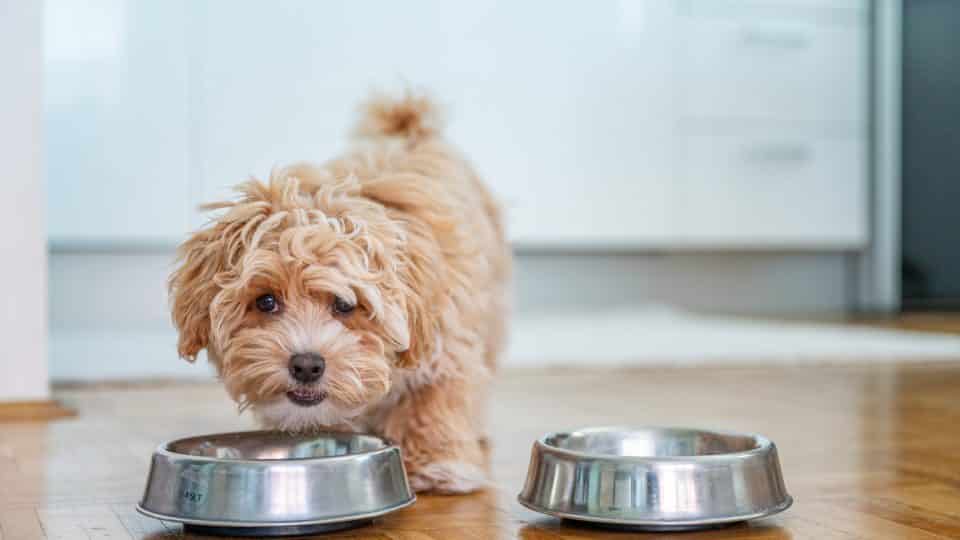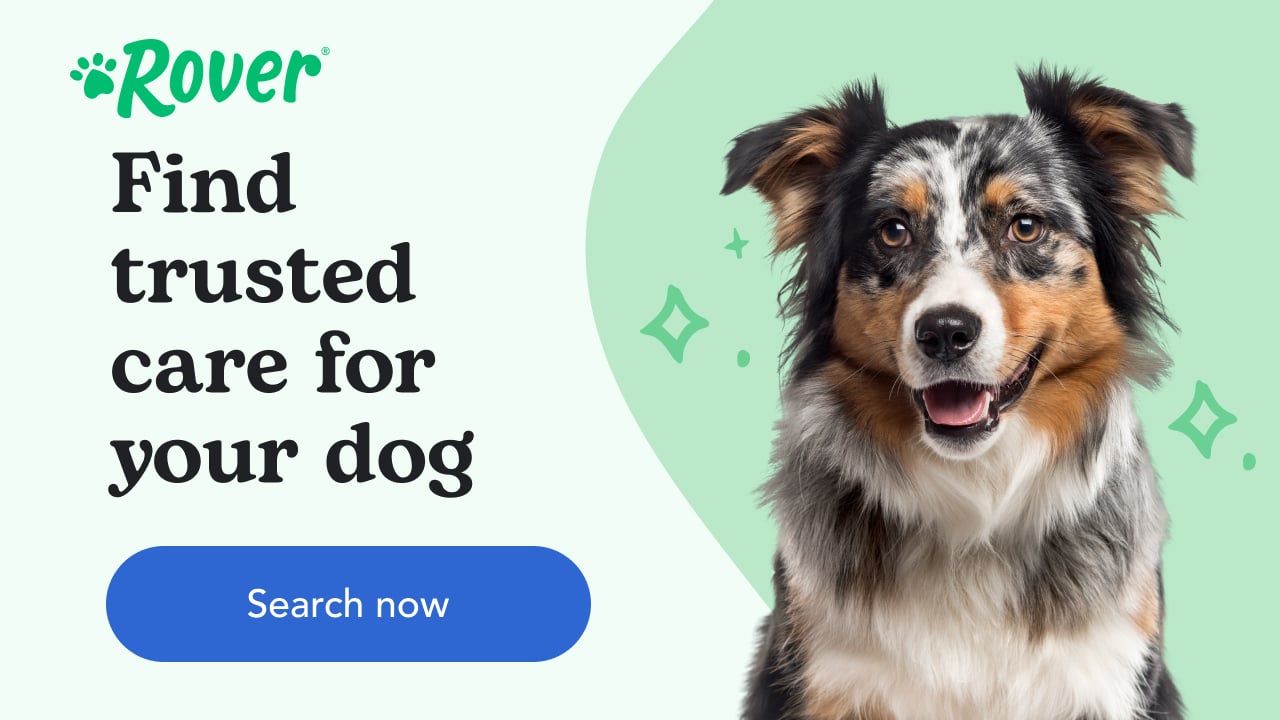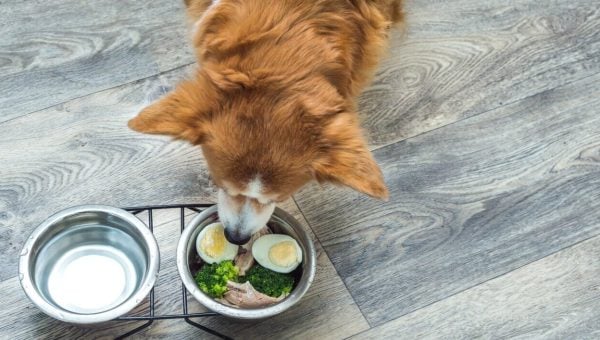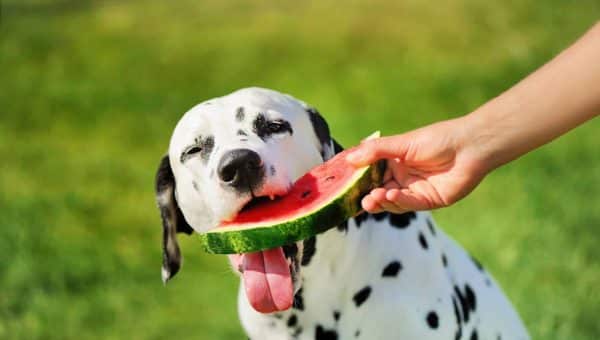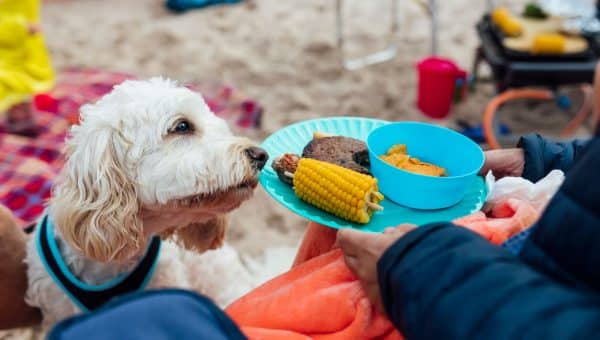As a new dog or puppy parent, one of the first things you’re likely to ponder is how much food your new dog needs. Similarly, owners of dogs who’ve lost weight or gained a few pounds may question the amount of food they’re giving their dogs. Getting the right amount is slightly more nuanced than reading a food label.
How much food your dog needs depends on several important factors such as:
- type of food
- your dog’s breed
- activity level
- body weight
- number of meals
Whether you have a dog whose mantra is “live to eat” or “eat to live,” one of the most important things you can do for your pet’s lifelong health is to help them maintain a healthy weight—and that starts with a combination of feeding the right amount of food and the right amount of exercise.
But just what is the “right” amount? And how do we account for a dog’s changing nutritional needs as they grow? We researched guidelines and spoke to veterinary experts to break down exactly how to find the right amount of food for your dog.
What Factors Affect How Much You Feed Your Dog
While they’re a helpful guide (and a good place to start), dog food feeding charts have their limitations. Namely, they don’t take into account your dog’s lifestyle and genetics, which both play a role in feeding amounts.
“Dogs, like people, are all individuals and their caloric needs will vary,” says Dr. Jamie Whittenburg, Veterinarian and Director of Kingsgate Animal Hospital in Lubbock, Texas.
The following factors influence how much to feed a dog:
- Weight. If your dog is over or underweight, her daily intake may need to be changed temporarily until she reaches a healthy weight. Your vet may also recommend switching to a special dog food formulated for weight loss or weight gain.
- Activity levels. On their own, feeding charts are never 100% accurate because they don’t account for your dog’s exercise habits. It makes sense, then, that a high-octane Border Collie might require more food than a sleepy Bulldog. As Dr. Linda Simon, MVB MRCVS, a London-based veterinary surgeon, tells us: “A dog that spends time in a kennel, or one who isn’t exercised a lot, won’t need a large amount of calories.”
- Puppyhood: It’s no surprise that all those puppy antics require food with high amounts of protein, fat, nutrients, and calories. A puppy’s growing body needs more calories than an adult dog, with more frequent feedings.
- Adulthood: As an adult dog’s metabolism slows down, his calorie requirements will follow suit. Once your puppy transitions to adulthood, they can usually drop to two meals per day.
- Senior dogs: Older dogs with health concerns might benefit from a special formula diet that delivers the particular nutrients they need. And as they become more sedentary, some senior dogs can transition to once-a-day meals. But always talk to your vet before eliminating a meal.
- Food brands: The average cup of dry dog food can have anywhere from 350-600 calories. Depending on your dog’s calorie needs, you may need to adjust serving amounts to avoid over or under-feeding your pet.
Should You Feed By Calories or Cups?
While going by a food’s feeding chart recommendations is, admittedly, the easiest route, it may not necessarily be the best or healthiest approach for your dog’s needs. The feeding guide on the dog food label is not monitored by an organisation the way human nutrition labels are. So even though dog food bags must include a feeding guide on the label, it may not be tailored for your dog’s needs.
In many cases, the feeding instructions found on dog food labels don’t align with the standards set by the Pet Nutrition Alliance. Sometimes, this is because the company’s calculations were based on more active dogs than the average household pet. Dr. Simon admits: “It’s not uncommon for owners to have to tweak feeding guidelines by as much as 20%.”
Luckily, Dr. Whittenburg informs us there’s a pretty easy solution: online calorie calculators.
“Calculators are easier to use and more accurate than charts, as they can be much more precise as opposed to providing ranges. They also are able to take into account sex, body condition score, and activity level.”
Pro-tip: Dr. Whitenburg’s go-to calorie calculator is by The Pet Nutrition Alliance. This useful tool can help you figure out how many calories your dog needs. “Once you know how many daily calories your pet requires, a simple calculation based on the calories in their food will yield the amount required to be fed,” she says. After you’ve calculated how much calories your dog needs, you can then remeasure your dog’s daily food in cups or grams.
How to Read Dog Feeding Charts
To label dog food that meets the AAFCO’s “complete and balanced” standards, dog food companies must include feeding direction on their packaging. Typically, these are laid out in an easy-to-read table, and daily serving amounts are based on your pet’s weight. Using the pet food calorie calculator, you may be able to determine if your dog food label has the right feeding guidelines, or if you need to re-calibrate how much your dog needs.
To get an idea of what a feeding chart might look like, here’s a sample based on a typical dry food for adult dogs:
| Dog’s Weight | Food Per Day |
| 1-5.5 kilograms | ½ – 1¼ Cups |
| 5.5-9 kilograms | 1⅓ – 1¾ Cups |
| 9-16 kilograms | 1¾ – 2½ Cups |
| 16-23 kilograms | 2½ – 3¼ Cups |
| 23-34 kilograms | 3¼ – 4¼ Cups |
| 34-45 kilograms | 4¼ – 5½ Cups |
| Over 45 kilograms | 5¼ + ⅓ cup for each additional 4.5 kilograms |
Tip on switching dog foods: However, feeding charts are not universal. Dog food brands can vary in calorie count, depending on the brand. This is important to remember if you ever switch dog foods. If the new food has different caloric amounts per cup, you will need to adjust your dog’s meal size to maintain their current weight.
How Often and How Much Should You Feed a Puppy
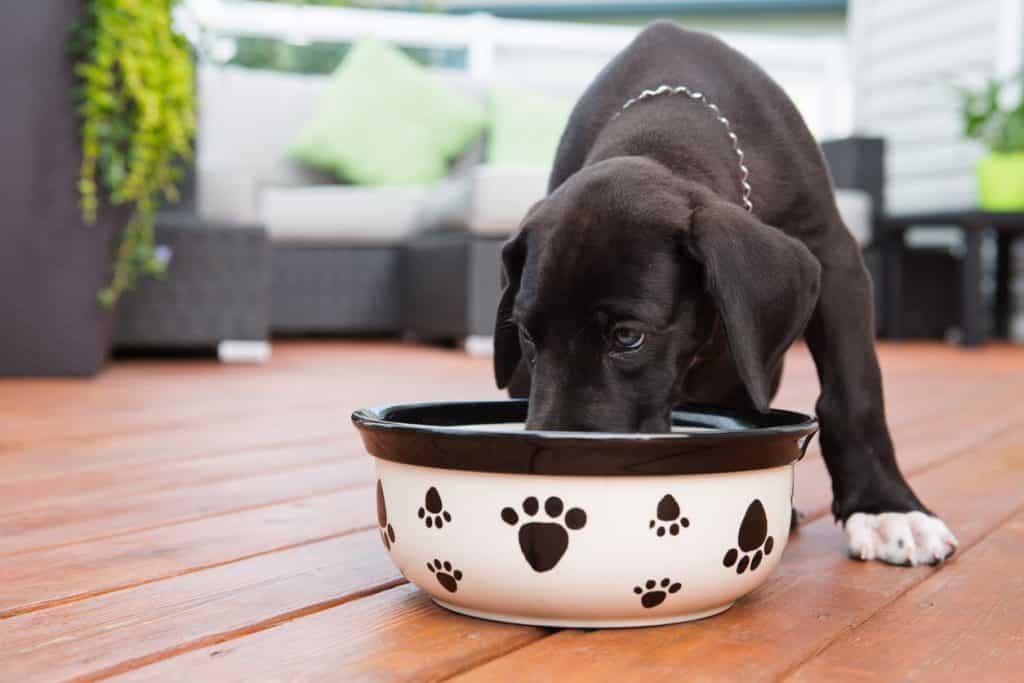
iStock/ChristopherBernard
Puppies’ nutritional needs are of course different from an adult or even adolescent dog. For starters, they often eat more times a day than adult dogs. Depending on your puppy’s breed and age, she may eat up to four meals per day or two to three times the amount of an adult dog.
AKC recommends a method called “watch the dog, not the dish.” Giving puppies a schedule for their meals, and then taking away any leftover food 10-20 minutes after a meal is served, helps to establish good eating habits.
This method will help you to learn how much your puppy needs and helps your pup to establish good habits, as in: if you’re hungry, eat!
If a puppy misses out by not eating enough at one meal, their hunger will help them finish their meal at the next feeding and learn to eat when the food is available. And because they have frequent meals, they won’t go hungry for long.
How much your puppy eats is also dependent on her breed size:
- Toy and small breeds: four to six meals per day
- Medium breeds: three meals per day
- Large breeds: three to four meals per day
How Often and How Much Should You Feed an Adult Dog?
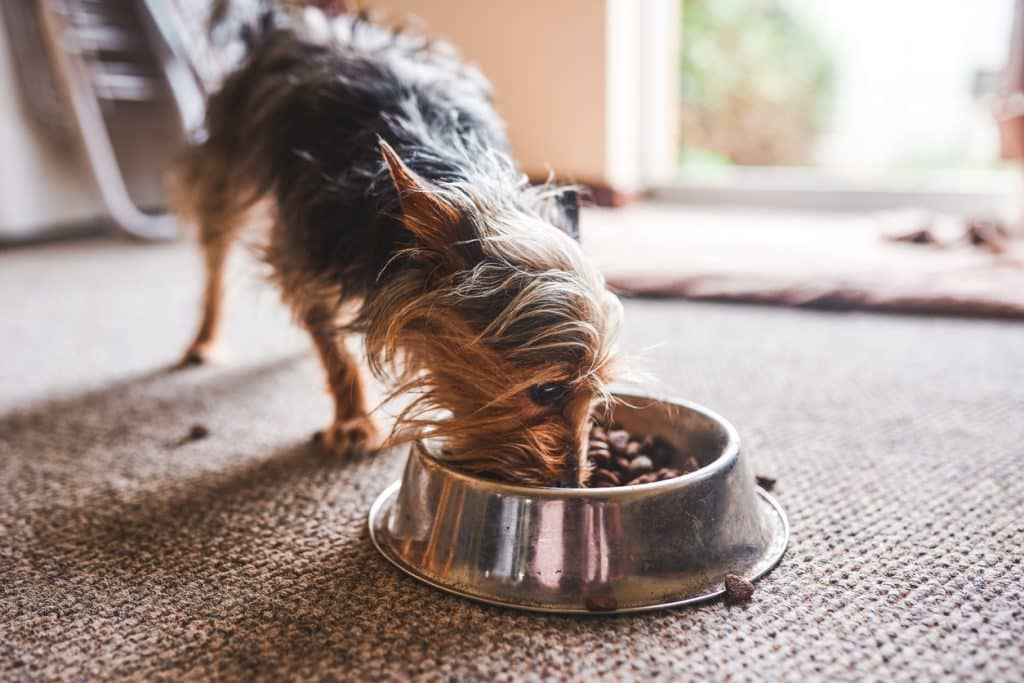
iStock/Moyo Studio
Most breeds of adult dogs eat twice a day, according to both of our experts. If you are adopting an adult dog and aren’t familiar with her eating habits, two cups of age-appropriate food per day is a good place to start—one in the morning and one in the evening, and always with fresh water available.
Dog food companies often market foods for different stages of life, so it’s easy to find a food designed for your dog at her stage of life.
If you’re still at a loss, try PetMD‘s general rule of thumb for adult dogs:
- Toy Breeds (1kg-3kg): 1/3 cup to 1/2 cup per day
- Small Breeds (4.5kg-9kg): 3/4 cup to 1 1/2 cups per day
- Medium Breeds (13.5kg-23kg): 1 3/4 to 2 2/3 cups per day
- Large Breeds: (27kg-45kg): 3 to 4 1/2 cups per day, plus 1/3 cup for every 4.5kg over 45kg
No matter the amount you land on, all dogs will benefit from a consistent feeding schedule. Feeding your dog at the same time, in the same place every day will help her feel safe and secure. It also builds trust between the two of you. Plus, it will help her maintain a healthy metabolism.
Below, we’ve broken down three common methods for feeding your dog—with the benefits and drawbacks of each.
Free-feeding
Depending on their personality, some adult dogs may be responsible enough to decide how much food is enough. Owners of these “eat to live”-type dogs often have little trouble helping their dog to maintain a healthy weight, as long as the dog gets enough exercise. In this case, you’d leave food out during the day and let the dog decide how much she wants.
It’s definitely the easiest way to feed your dog, but for the majority of dogs, free-feeding doesn’t work out.
“This is generally because dogs are notorious for eating more than they should, and becoming obese if we give them the chance,” Dr. Simon explains. Free-feeding also presents the risk of spoiling, especially in super hot climates. And it can become a problem in multi-pet households or homes with young children.
Dr. Whittenburg agrees: “Free-feeding not only leads to overconsumption and obesity in most dogs, but it can also make it difficult later in life to switch the dog to scheduled meals if necessary for a medical condition like diabetes.”
One exception, according to Dr. Whittenburg, are young puppies who can’t be meal-fed often enough.
Scheduled feeding
For those of us with “live to eat”-type dogs, we need to help our dogs with portion control. For most healthy, adult dogs, scheduled feeding is the best option.
Dr. Whittenburg lays out the following tips for schedule feeding:
- Provide a minimum of two meals per day
- Give meals at roughly the same time every day
- Allow your dog to eat, undisturbed, for 30 minutes
- Pick up any remaining food
Scheduled meals should also be used for dogs with certain medical conditions, including Bilious vomiting syndrome. “When not fed often enough, these dogs are prone to nausea and vomiting,” Dr. Simon tells us. “Feeding these dogs on a schedule works best and this will usually mean several feeds, including one in the early morning and one last thing at night.”
Once a day feeding
Opinions on this method are somewhat divided. According to Dr. Whittenburg, it’s not ideal. “As adults, once a day feeding is acceptable if absolutely necessary, but I find that pets do better with twice daily feeding. Can you imagine if you only got to eat once a day? It can lead to anxiety and gorging in pets.”
While most dog owners will stick with a twice-a-day meal schedule, there is growing evidence that some dogs may benefit from dropping down to one meal a day.
Dr. Simon fills us in. “A recent study has shown that feeding once daily may be better for our dogs and could even prolong lifespan. These dogs tended to suffer from orthopedic and gastrointestinal illness less than those fed twice daily.”
While the study has its limits and can’t conclusively say whether once-a-day feeding is better, it draws a plausible link. Future studies are still needed, as researchers in the study acknowledge. Consult your own veterinarian before eliminating any meals.
How Much Homemade or Canned Food Should I Feed My Dog?
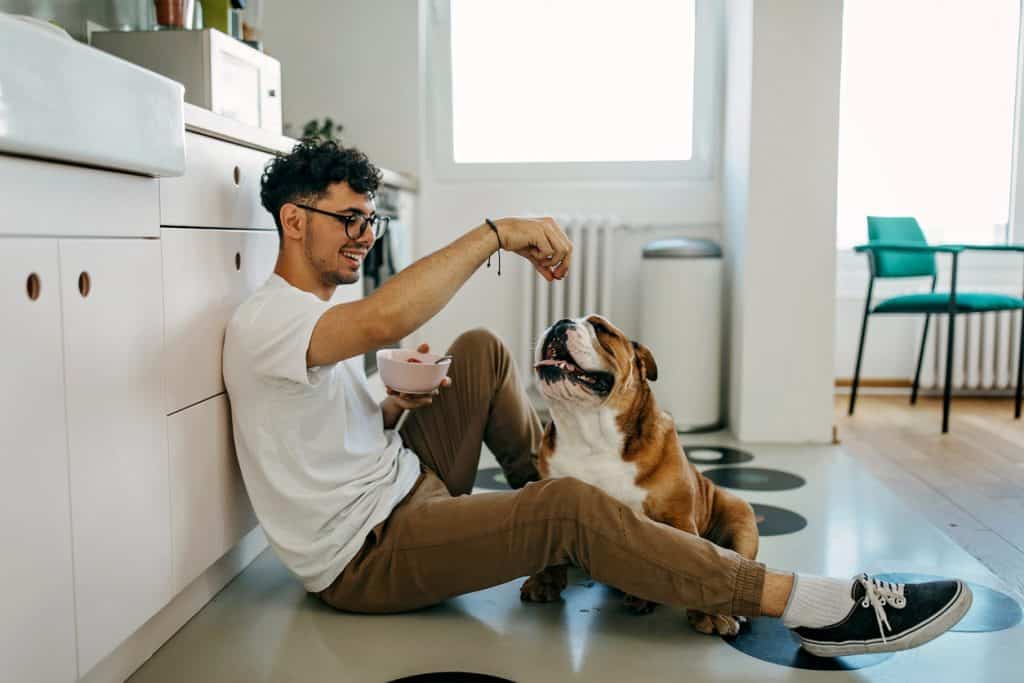
iStock/supersizer
Some pet owners prefer to prepare their own food for their dogs, which can have some benefits over store-bought kibble. For starters, homemade food can be more palatable. It’s also customisable, and owners who go down this route can feed these foods at all stages of life without transitioning from puppy to adult to advanced-age dog food.
Alternatively, fresh dog food subscriptions take the guesswork out of preparing whole foods. These companies create recipes that meet AAFCO standards for nutritionally balanced pet food, so you can be certain your dog is getting the vitamins and minerals she needs.
Wet food can be a pricier option that dogs tend to prefer over dry kibble, but it’s important to note the calorie differences. Usually, canned food has higher fat and protein content, but dry food is higher in calories per gram.
Tip: Try using homemade, canned, or fresh food as toppers to your dog’s meal. This is an economical way to boost your dog’s nutrition AND her food’s palatability.
How Do Treats Factor in Daily Feeding?

iStock/ChristopherBernard
As a general rule, dog treats should make up no more than 10% of your dog’s daily caloric intake. Plan treats accordingly if you are in a training program, to make sure that they aren’t getting too many.
If you have a dog who is already overweight, consider creative treat ideas that don’t add many calories. We once had a dog who loved green beans—a nice low-calorie “treat.”
Use the Body Condition Score to Check Your Dog’s Health
“When a dog is not the correct weight, we should determine what their Body Condition Score is and then calculate their ideal weight,” says Dr. Simon. “We can then alter how many calories they need each day.”
The BCS is a quick survey of your dog’s physique. Based on the BCS, you can gauge whether your dog is getting enough food and exercise:
- First, your dog should have an “hourglass” figure when you look at them from above. What this means is that you should see wider shoulders and ribs, a tapering behind the ribcage, then widening again at the hips.
- Second, when looking at them from the side, their ribs should be closer to the ground than the belly. This “tucked up” look is how you see a dog’s natural waist line.
- Last, the ribs shouldn’t be visible, but you should be able to feel them with your hand with only slight pressure.
Ultimately, the best way to identify your pet’s ideal weight is to speak with your vet. From there, you can devise a healthy weight management plan.
Takeaway: Look at Portion Size and Exercise
Good nutrition is an integral part of your dog’s overall wellness. And figuring out her proper portion size is a big step you can take towards better health.
While it can happen to anyone, it’s important to help bring your dog to a healthy weight if she’s obese. Untreated, obesity can lead to a string of health issues, including musculoskeletal problems, congestive heart failure, Cushing’s disease, skin disorders, and some types of cancer.
Underweight dogs also face potential health problems, such as weakened immune systems and loss of muscle strength. If your dog is overweight or underweight, it’s best to consult your vet for assistance in getting her back on track.
